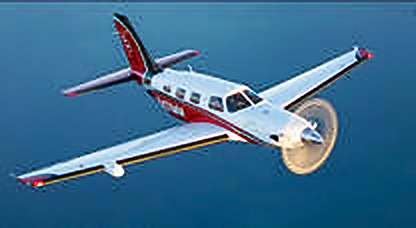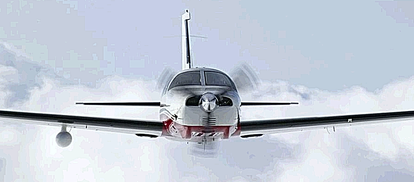
Initial PA46 Pilot Training
- A copy of the RWR Pilot Training PA46 Standard Operating Procedures
- A copy of the pilot information manual (PIM) for your aircraft (PDF)
- Access to the PA46 Pilot Reference Library
Training Course Outline
Introduction to Systems and Limitations
- Cockpit Procedures Training (CPT): CPT is designed to allow each pilot to discover everything on your specific aircraft panel, how it functions and how it is integrated into various flight conditions. The avionics are powered up with an external 28V DC power source and thoroughly reviewed. Each annunciator light is discussed including the relevant checklist. Checklists, flows and memory items (normal, abnormal and emergency) are reviewed in detail in preparation for the first flight in the aircraft.
- Familiarization Flight #1: The first flight in the aircraft is usually conducted in visual meteorological conditions (VMC) and is used to “discover” basic power settings and pitch attitudes that can be replicated for various flight regimes. Airwork is conducted to explore the aircraft’s flight envelope and includes stalls, steep turns, unusual attitudes and other basic maneuvers found in the FAA Practical Test Standards for the rating held. These maneuvers are done using typical and realistic scenarios at a safe altitude. Aeronautical decision making (ADM) and risk management (RM) will be emphasized as they pertain to these flights.
- Familiarization Flight #2: This flight allows you to transition to the VFR approach and landing environment where we will perform practice landings and takeoffs. We will use wind conditions to set up crosswinds and conduct short field operations as well. I will share strategies for determining safe runway length. We may also perform zero thrust landings to a designated spot. Aeronautical decision making (ADM) and risk management (RM) will be emphasized as they pertain to these flights. All flight maneuvers are conducted in accordance with the FAA ACS.
- Flight Review / IPC and Systems Review: This oral review is given as a way to review the information already presented, as well as a thorough review of the FAA regulations governing part 91 operations. It exceeds the requirements for the ground instruction required by the FAA for the biannual flight review.
- Familiarization Flight #3: Straight and level flight, climbs, turns, descents, basic holds, tracking and DME arcs will be flown in actual or simulated instrument conditions. We will use and integrate each item of avionics in your specific panel (ADF, GPS, RNAV, WAAS, radar altimeter, storm scope, weather radar, electronic charts, weather up/downlink etc) until you know when and how to use them. Aeronautical decision making (ADM) and risk management (RM) will be emphasized as they pertain to these flights.
- Familiarization Flight #4: Precision and non-precision approaches will be flown to published minimums. The concept of the visual descent point (VDP) will be thoroughly integrated. When you have mastered them (with and without the autopilot), we will work on partial panel (raw data) approaches and various other simulated abnormal and emergency conditions. Aeronautical decision making (ADM) and risk management (RM) will be emphasized as they pertain to these flights.
- Pre-LOFT (line oriented flight training) Review: This is a planning session that will make the LOFT portion of your training more effective. We will discuss flight planning and review weight and balance and performance issues. High altitude flight strategies and emergencies are discussed.
- Flights #5, #6, #7, & #8: LOFT is your opportunity to put it all together and conduct several legs of cross-country flight. You pick the places, plan the flights (including fuel calculations and weight and balance), file an instrument flight plan and fly your aircraft at its service ceiling. We will review all aspects of high altitude physiology, pressurization, abnormal and emergency procedures, aeronautical decision making (ADM) and risk management (RM) as they pertain to these flights.

Completion Standards
Completion standards are in accordance with FAA Airman Certification Standards for the rating held, usually Private Instrument, although the training is presented with ATP standards. This level of proficiency will make you a safer, more confident pilot. Upon successful completion, you will receive a Certificate of Completion and endorsements for biannual flight review, instrument proficiency check, and high altitude operation (where applicable). If standards for the rating held are not met in the time allotted, we will formulate a strategy for getting you to the required level of proficiency and develop a supplemental training schedule that is likely to be successful for you. If you perform to ATP standards during the training and you agree to adopt the PA46 standard operating procedures, you qualify for and will receive the coveted PA46 ProCard. In addition to recognizing your excellent performance, this card may entitle you to discounts on your aviation insurance.
This course is offered at the location(s) of your choice worldwide. It requires that you be currently licensed by the FAA or the National Aviation Authority of your country to fly airplane single engine land (ASEL) aircraft. You must provide an airworthy Piper PA46 (M350, M500, M600, Matrix, Malibu, Mirage, Meridian or JetProp DLX) aircraft for the training. This course is approved worldwide by the Insurance Industry, FAA Industry Training Standards (FITS) and FAA Wings.
Each training program presumes you are rated and current for instrument flight, have at least 500 Hours PIC time in high performance fixed wing aircraft and have reviewed the AFM. This is not required; however, if a pilot is unable to complete the training in the allotted time (for any reason including weather, aircraft maintenance, personal or business schedule), cancellation charges, wait charges and/or a supplemental training fee may apply.
Excellent training doesn’t take any longer or cost any more. Here are ten things you should consider before choosing your PA46 training and related service provider.
